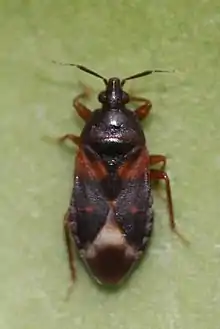Lyctocoridae
Lyctocoridae is a reconstituted family of bugs, formerly classified within the minute pirate bugs of the family Anthocoridae.[1] It is widely distributed, with one species (Lyctocoris campestris), being cosmopolitan.[2][3]
| Lyctocoridae | |
|---|---|
 | |
| Lyctocoris dimidiatus | |
| Scientific classification | |
| Domain: | Eukaryota |
| Kingdom: | Animalia |
| Phylum: | Arthropoda |
| Class: | Insecta |
| Order: | Hemiptera |
| Suborder: | Heteroptera |
| Superfamily: | Cimicoidea |
| Family: | Lyctocoridae Reuter, 1884 |
Description
Lyctocoridae range in length from 2 mm to 6 mm. They have tarsi 3-segmented, forewing with a costal fracture and with weakly developed veins in the membrane, laterotergites on all abdominal terga, and male genitalia strongly asymmetrical (left paramere larger than the right).[2]
Overall they resemble the related family Anthocoridae, but can be distinguished by:
- In males, the left paramere is flat, with a single-sheet form, and without a median sulcus. The phallus is tubular and well visible, with ductus seminis striated transversely and extended apically by a needle-shaped acus.[4]
- In females, there are genital apophyses in the anterior region of abdominal sternum 7.[4]
Diet
Lyctocoridae are mostly predators of small, soft-bodied arthropods, though L. campestris occasionally feeds on mammal (including human) blood[2][3] and L. ichikawai is only known to feed on sap of sawtooth oak (Quercus acutissima).[5] Adults and nymphs have similar diets.[4]
Habitat
This family of bugs occurs under tree bark and in decaying plant matter, animal nests and burrows, manure piles, poultry houses, granaries and stored food products.[2][3]
Reproduction
Lyctocoridae practice traumatic insemination in which the male pierces the female (using the acus of his phallus) between terga 7 and 8 on the right side of her abdomen. The male's sperm migrate through the haemocoel or through specialized structures in the female to the ovaries, then fertilise the eggs within the vitellarium.[3]
Biological control
Some species of Lyctocoridae are biological control agents that feed on pest insects. Xylocoris and Lyctocoris attack beetle and moth pests in stored food products, and these genera along with Scoloposcelis attack bark beetle pests.[3]
Systematics
Recent phylogenetic work supports the treatment of Lyctocoridae as a family separate from Anthocoridae.[1]
Genera
BioLib lists a single subfamily Lyctocorinae Reuter, 1884:
- Lyctocoris Hahn, 1836 (in monotypic tribe Lyctocorini Reuter, 1884)
- Astemmocoris Carayon & Usinger, 1965
Placed elsewhere
Many of these are placed in the Anthocorinae tribes Cardiastethini[6] and Scolopini:
- Alofa Herring, 1976
- Amphiareus Distant, 1904
- Brachysteles Mulsant & Rey, 1852
- Buchananiella Reuter, 1884
- Calliodis Reuter, 1871
- Cardiastethus Fieber, 1860
- Dufouriellus Kirkaldy, 1906
- Dysepicritus Reuter, 1885
- Nidicola Harris and Drake, 1941
- Orthosoleniopsis Poppius, 1909
- Physopleurella Reuter, 1884
- Scoloposcelis Fieber, 1864
- Solenonotus Reuter, 1871
- Xylocoridea Reuter, 1876
- Xyloecocoris Reuter, 1879
References
- Schuh, Randall T.; Weirauch, Christiane; Wheeler, Ward C. (2009). "Phylogenetic relationships within the Cimicomorpha (Hemiptera: Heteroptera): a total-evidence analysis". Systematic Entomology. 34 (1): 15–48. CiteSeerX 10.1.1.498.8756. doi:10.1111/j.1365-3113.2008.00436.x. ISSN 1365-3113. S2CID 85422423.
- Schuh, R. T.; Slater, J. A. (1995). True bugs of the world (Hemiptera: Heteroptera) : classification and natural history. New York, USA: Cornell University Press. ISBN 0-8014-2066-0. OCLC 31132787.
- Horton, D. R. (2008). "Minute Pirate Bugs (Hemiptera: Anthocoridae)". In Capinera (ed.). Encyclopedia of Entomology (J. L. ed.). Springer, Dordrecht. pp. 2402–2412. doi:10.1007/978-1-4020-6359-6_4633. ISBN 978-1-4020-6242-1.
- Carpintero, Diego L. (2015), Panizzi, Antônio R.; Grazia, Jocélia (eds.), "Minute Pirate Bugs (Anthocoridae and Lyctocoridae)", True Bugs (Heteroptera) of the Neotropics, Entomology in Focus, Dordrecht: Springer Netherlands, vol. 2, pp. 217–236, doi:10.1007/978-94-017-9861-7_9, ISBN 978-94-017-9860-0, retrieved 2022-09-09
- Yamada, Kazutaka; Yasunaga, Tomohide; Ichikawa, Toshihide (2012-10-24). "A new species of Lyctocoridae (Hemiptera: Heteroptera: Cimicoidea) feeding on the exuded sap of Sawtooth Oak, Quercus acutissima, in Japan". Zootaxa. 3525 (1): 65. doi:10.11646/zootaxa.3525.1.5. ISSN 1175-5334.
- BioLib: tribus Cardiastethini Carayon, 1972 (retrieved 10 April 2022)
External links
![]() Media related to Lyctocoridae at Wikimedia Commons
Media related to Lyctocoridae at Wikimedia Commons